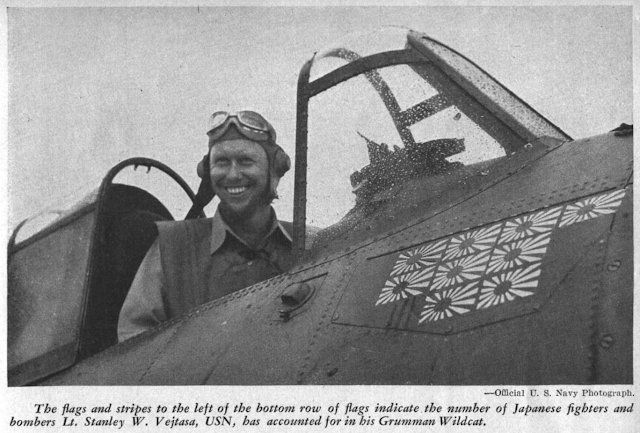Hello ladies and gents this is the viking telling you that today we are talking about
STANLEY VEJTASA
Stanley Winfield "Swede" Vejtasa (27 July 1914 – 23 January 2013) was a United States Navy career officer and World War II flying ace. During the Battle of the Santa Cruz Islands, he shot down seven Japanese aircraft on 26 October 1942, becoming an "ace in a day"
He joined the Navy in 1937 and became a Naval Aviator on 13 July 1939. Commissioned an ensign in August, he was first assigned to Scouting Squadron Five (VS-5) aboard the aircraft carrier USS Yorktown (CV-5) that same month, flying the Douglas SBD Dauntless.
World War II
After the United States entered World War II, then Lieutenant (junior grade) Vejtasa attacked three Japanese "aircraft tenders or transports", scoring a direct hit on one of them "near Salamaua and Lae, New Guinea", on 10 March 1942, for which he was awarded his first Navy Cross.
During the Battle of the Coral Sea, he was one of several dive bomber pilots who struck and sank the Japanese light aircraft carrier Shōhō on 7 May 1942. The next day, he shot down two Mitsubishi A6M Zero fighters and took out a third in a collision, despite flying the much slower but hardy SBD Dauntless dive bomber. For his actions during the battle, he was awarded his second Navy Cross. Walter Schindler, a future vice admiral, filmed the naval battle as Vejtasa's rear gunner.
Vejtasa was transferred to fighters, piloting the Grumman F4F Wildcat, and was assigned to the newly formed Fighting Squadron 10, under Lieutenant Commander James H. Flatley, aboard the USS Enterprise (CV-6). During the Battle of the Santa Cruz Islands, he shot down seven enemy aircraft on 26 October 1942 – first two Aichi D3A "Val" dive bombers attacking the USS Hornet (CV-8), then five Nakajima B5N "Kate" torpedo bombers targeting the Enterprise – becoming an "ace in a day".
Lieutenant Vejtasa was awarded his third Navy Cross for this achievement. Seventy years later, an attempt to upgrade this to the Medal of Honor was denied. He is the only World War II carrier pilot awarded the Navy Cross "for both dive bombing and aerial combat."
He left Flying Squadron 10 in May 1943 and returned to the United States to serve as a flight instructor at Naval Air Station Atlantic City. He saw no further combat. At the end of the war, his tally was 10.25 victories, including a quarter shared credit for a Kawanishi H6K "Mavis" flying boat on 13 November 1942.
Post-war
Vejtasa remained in the Navy after the end of the war and served in the Korean War as air officer aboard the USS Essex (CV-9) from 1951 to 1953. He commanded the ammunition ship USS Firedrake (AE-14) from July 1959 to August 1960 and the aircraft carrier USS Constellation (CV-64) from November 1962 to November 1963. He received the Legion of Merit for his work as Commander Fleet Air, Miramar, from 15 August 1965 to 7 June 1968. He retired on 1 July 1970 as a captain.
I hope you liked this post and as always have a chilled day from the Viking.

Comments
Post a Comment